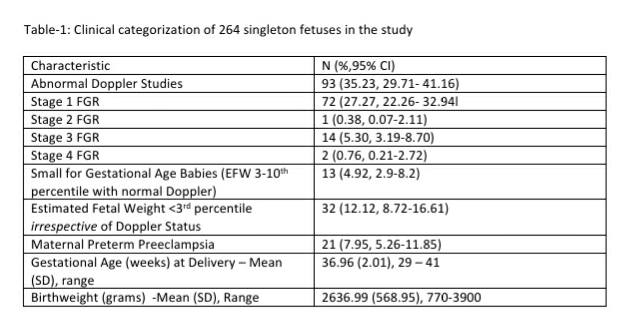Authors: Rijo M Choorakuttil1,2, C. Amarnath3,4, Sandeep Kavthale5,6, Praveen K Nirmalan7
Author Affiliation:
- AMMA Center for Diagnosis and Preventive Medicine, Kochi, Kerala, India
- National Co-ordinator, National Preventive Radiology Program, Indian Radiological and Imaging Association (IRIA), India
- President, Indian Radiological and Imaging Association (IRIA), India
- Professor and Head, Government Stanley Medical College, Chennai, Tamil Nadu
- Secretary, Indian Radiological and Imaging Association (IRIA), India
- Vision Diagnostic Center, R-3, 1058, Tilak Nagar, Latur 413512, Maharashtra
- Chief Research Mentor, AMMA Education and Research Foundation and Lead Faculty, AMMA Healthcare Research Gurukul, Kochi, Kerala, India
Corresponding Author: Dr Rijo M Choorakuttil, National Co-ordinator, National Preventive Radiology Program, Indian Radiological and Imaging Association (IRIA), India
E-mail: preventiveradiologyiria@gmail.com
Conflicts of Interest: None
Key Words: Nonalcoholic Fatty Liver Disease, Ultrasound, Screening, Diagnosis
Introduction:
The prevalence of Nonalcoholic Fatty Liver Disease (NAFLD) is increasing rapidly worldwide and is recognized as the leading cause of chronic liver disease in many countries.1-6 A recent meta-analysis estimated the prevalence of NAFLD as 25.24% in the general population.4 The prevalence of NAFLD based on a cohort study from south India is reported as 49.8%, which is significantly higher than the global pooled estimate.7 Obesity and type 2 Diabetes Mellitus (T2DM) are major risk factors with a reported prevalence of 50% to 90% NAFLD among obese subjects and a pooled prevalence of 59.67% for NAFLD among persons with type 2 Diabetes Mellitus.8-12 Asian Indians have a higher risk of T2DM even at lower body mass indices compared to other ethnicities13-15 and are therefore more at risk for NAFLD.
Prevention is an important strategy in the management of NAFLD and early diagnosis can play an important part in effective prevention or early lifestyle changes. We designed a nation-wide survey to obtain a better understanding of the awareness of NAFLD and NASH within an unselected group of Radiologists in India. This will help us understand awareness regarding the magnitude of NAFLD in India, the specific screening and diagnostic tests used and current management strategies for NAFLD and NASH.
Material and Methods
An anonymized questionnaire was developed in Google forms and the link to the form was sent to Radiologists in India through the IRIA. The questionnaire included basic demographic questions including age and gender, years of experience in the practice of Radiology and type of practice. Questions also elicited information on risk factors, management strategies and screening strategies and referral patterns for NAFLD. Information on specific training for NAFLD and familiarity with guidelines was sought from respondents. The questions were closed-ended with multiple choices available.
The data was collated from the Google forms into a google spreadsheet located in a password protected google drive folder in real-time. The data was exported to STATA (V12.0) for subsequent analysis.
Results
Three hundred and twenty-seven radiologists from India responded to the survey. The mean (SD) age of respondents was 42.39 (10.99) years (median 41 years, Interquartile range: 33 to 50 years) and 64.83% respondents were females. The mean (SD) years of Radiology practice (See Figure-1) of respondents was 14.78 (9.71) years. Figure-1 shows the distribution of respondents by practice sector. The knowledge of respondents regarding the prevalence of NAFLD in India is shown in Figure-3.
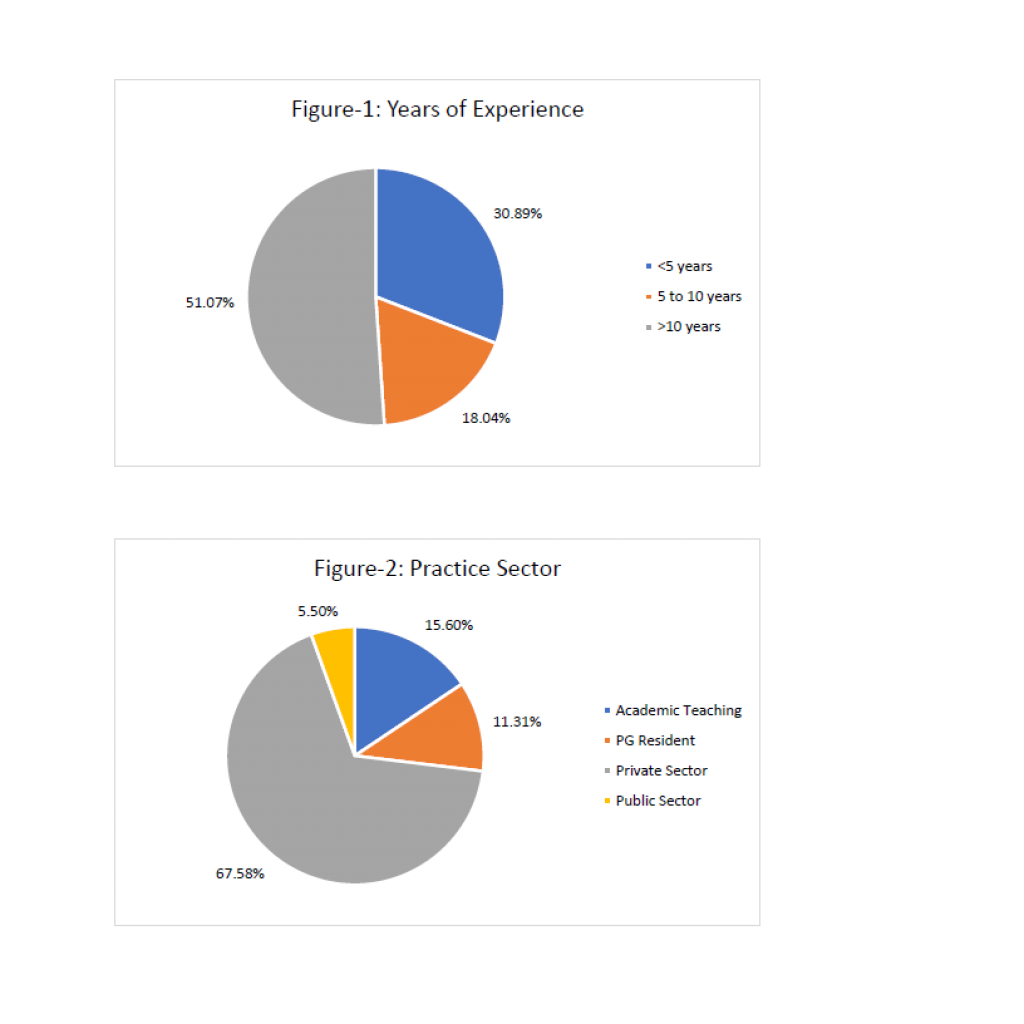
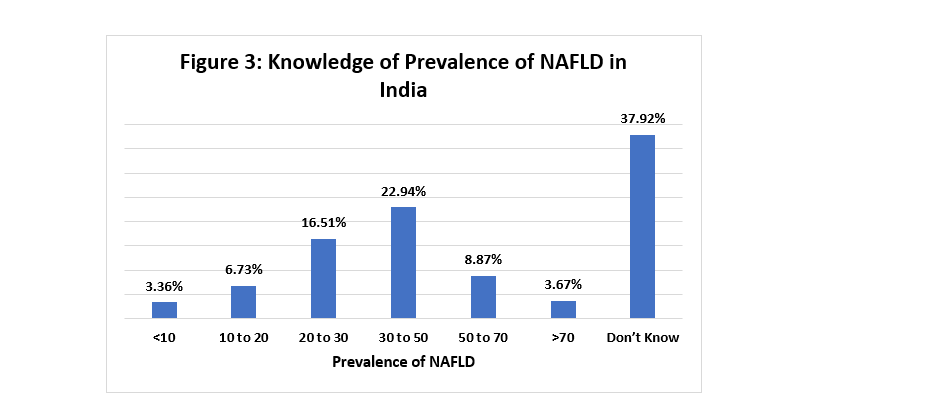
NAFLD was recognized as a major problem in India by 88.38% of respondents and 75.23% of respondents said they screen regularly for NAFLD in their clinical practice. However, one-third to one-half of respondents in each sector reported that they were unaware of the prevalence of NAFLD in India (see Figure-4). Nearly one-fourth of the respondents said they did not screen regularly for NAFLD. Most respondents reported screening for NAFLD in obese (83.79%) and Diabetes Mellitus (81.65%). 16.21% of respondents reported that they screened for NAFLD only if requested by the referring physician and 15.60% of respondents reported they did not perform any targeted screen for high-risk groups (see Figure-5) Most respondents (83.49%) were aware that NAFLD can occur in children, however, only 48.32% recommended family screening for NAFLD. The mean (SD) number of patients seen with NAFLD every month by respondents was 83.33 (111.51).
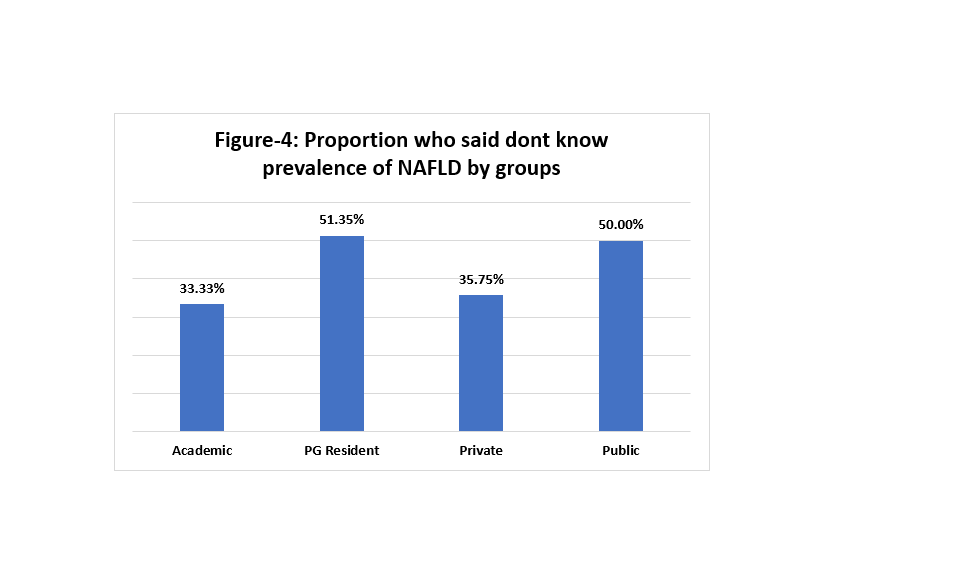
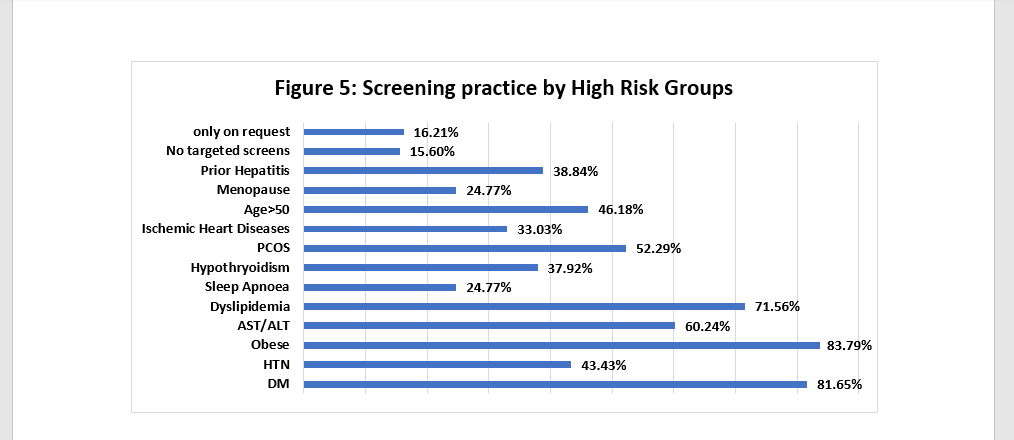
Ultrasound imaging (92.05%) was the most common diagnostic test done for NAFLD in this population (see Figure-6). Most (62.39%) respondents reported that they did not proactively suggest a liver biopsy for those identified as NAFLD on screening using imaging modalities (see Figure-7). Just over one-fourth (27.83%) of respondents said they did not proactively suggest biochemical tests for persons identified with NAFLD (see Figure-8). Lipid profiles were the most common recommended biochemical tests advised.
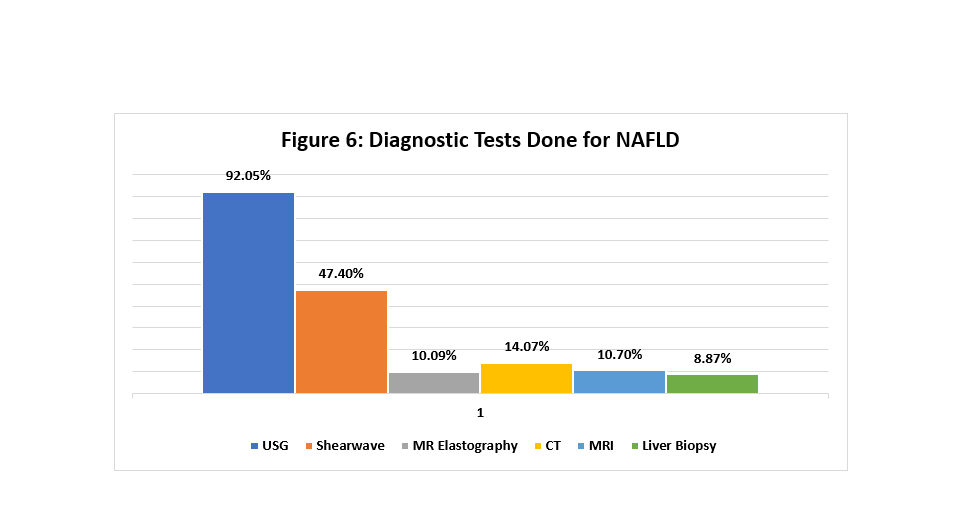

72.48% of respondents referred patients identified with NAFLD on screening back to the referring physicians. 42.51% of respondents advised consultation with a gastrointestinal specialist, 16.21% with an internal physician and 8.56% with an endocrinologist. More than 90% of respondents reported awareness of weight loss and exercise as important strategies in the management of NAFLD (see Figure-9). Only 34.25% of respondents reported reading guidelines on NAFLD and 7.25% reported having received any specific training on NAFLD. An overwhelming 89.64% of respondents indicated that they want additional training for NAFLD. Figure-10 shows the major barriers to NALFD screening in India as reported by the respondents.
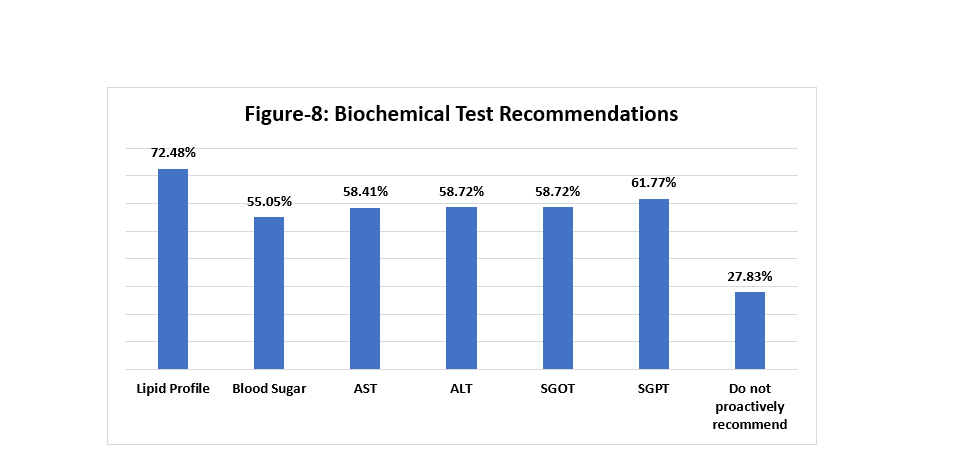
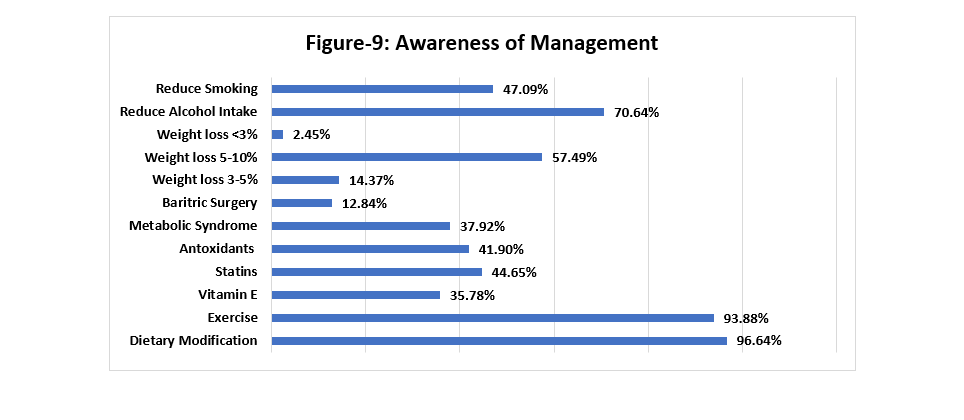

Discussion
NAFLD is defined as the accumulation of fat in ≥5% of hepatocytes in persons without significant alcohol consumption (<30 g/day for men and <20 g/day for women) or other secondary causes of hepatic steatosis. NAFLD is a spectrum that may range from simple steatosis to nonalcoholic steatohepatitis (NASH), advanced fibrosis, cirrhosis, and even hepatocellular carcinoma (HCC), liver failure and death. NASH related liver cirrhosis is increasingly recognized as among the major indications for liver transplants currently.17
India has an increasing prevalence of obesity and diabetes that has led to India being considered among the diabetes capitals of the world.13 Hypertension and Diabetes Mellitus are the leading cause of non-communicable disease in India which is different from causes of non-communicable diseases in other low-and-middle-income countries which are predominantly related to childhood nutrition and poor water quality.18
Clinical diagnosis of NAFLD is often an underestimation as the disease has a constellation of different clinical symptoms and signs, needs a high degree of suspicion and there are multiple tests with differing ability to identify the disease. Radiology imaging modalities are among the most preferred diagnostic tests for NAFLD. Imaging tests offer a subjective assessment that is painless and non-invasive with minimal or no contact. Radiologists, using imaging modalities, have an important role to play in the early identification of NAFLD and serial monitoring or surveillance of progress.
The results of this survey showed a high recognition of NAFLD as a major health issue in India. Most respondents were aware of the possibility of NAFLD occurring in children. However, nearly 40% of respondents did not know the range of prevalence of NAFLD in India. It is possible that the lack of awareness of the magnitude of NAFLD is related to the fewer studies on the epidemiology of NAFLD in India. The knowledge of conventional associations of NAFLD including obesity, diabetes mellitus, and dyslipidemia was high in the study population. The knowledge of associations with AST/ALT and polycystic ovary syndrome was moderate (50-70%) but was poor with emerging associations like sleep apnoea, ischemic heart disease, hypothyroidism, menopause and age > 50 years. There is a need to improve awareness of the high-risk groups associated with NAFLD especially as 15-16% of respondents stated they do not perform targeted screens for NAFLD in high-risk groups.
Radiologists can play a proactive role in the management of NAFLD instead of restricting themselves to the reporting of NAFLD. Most respondents in the study referred the subject back to the primary referring physician and less than half referred the subject for a gastrointestinal consult possibly deferring that decision to the primary physician. Most respondents did not proactively suggest a liver biopsy, which may be understandable considering the risks associated with the procedure and the possibility to perform a safe liver biopsy on a large scale. Although liver biopsy is considered the gold standard by most guidelines, it does not hold a prime position in pragmatic clinical practice. Interestingly, most radiologists did not recommend supportive biochemical tests as well possibly deferring the recommendation of investigations to the primary physician. This is a practice that radiologists must change, and they must proactively recommend appropriate investigations that support an appropriate interpretation of the imaging studies.
Several barriers were reported to the regular screening of NAFLD in India. The lack of confidence to do an imaging study was not considered a barrier. However, a significant proportion of study respondents (46.18%) felt that physicians do not actively act or integrate the findings of imaging studies indicating a breakdown in the interdisciplinary communication systems. This is an area that must be addressed on an urgent basis. Additionally, about 60% of respondents said they did not receive any referrals for NAFLD screening. The cost of imaging studies and time constraints were not considered as major barriers to screening for NAFLD using imaging studies. However, nearly 40% reported that patients do not want to be screened for NAFLD indicating the need for a larger health education program on NAFLD and risk groups associated with it.
A significant proportion of respondents expressed the need for specific training programs on NAFLD and the need for locally developed guidelines that are relevant to the local context. The request for training programs indicates that radiologists in India are aware of the problem of NAFLD in India and are actively seeking better training to address the problem.
The results of the survey highlight an important aspect. It is imperative that radiologists in India see themselves as an integral part of preventive healthcare programs in India. The expertise in imaging, possibility for objective painless minimal contact and affordable testing is important as preventive programs scale up in India. This will need radiologists to shift the paradigm from a “reporting based on referral” paradigm to a more comprehensive, proactive approach that also determines appropriate imaging tests based on clinical findings. A proactive approach by the radiologist can help improve early identification and initiation of early interventions that may possibly improve outcomes of various diseases. The national Preventive Radiology program of IRIA is a welcome initiative in this regard.
In conclusion, India has a high prevalence of NAFLD which is expected to increase further as India grapples with an epidemic of obesity and Type 2 DM. Imaging studies by radiologists can help early identification and early interventions including lifestyle changes. It is important that Radiologists in India train in the different modalities to identify NAFLD and be more proactively involved with its management in India.
References
- Loomba R, Sanyal AJ. The global NAFLD epidemic. Nat Rev Gastroenterol Hepatol 2013;10:686–690. doi: 10.1038/nrgastro.2013.171.
- Vernon G, Baranova A, Younossi ZM. Systematic review: the epidemiology and natural history of non-alcoholic fatty liver disease and non-alcoholic steatohepatitis in adults. Aliment Pharmacol Ther 2011;34:274–285. doi: 10.1111/j.1365-2036.2011.04724.x.
- Farrell GC, Wong VW, Chitturi S. NAFLD in Asia–as common and important as in the West. Nat Rev Gastroenterol Hepatol 2013;10:307–318. doi: 10.1038/nrgastro.2013.34.
- Younossi ZM, Koenig AB, Abdelatif D, Fazel Y, Henry L, Wymer M. Global epidemiology of nonalcoholic fatty liver disease-Meta-analytic assessment of prevalence, incidence, and outcomes. Hepatology 2016;64:73–84. doi:10.1002/hep.28431.
- Li Z, Xue J, Chen P, Chen L, Yan S, Liu L. Prevalence of nonalcoholic fatty liver disease in mainland of China: a meta-analysis of published studies. J Gastroenterol Hepatol 2014;29:42–51. doi: 10.1111/jgh.12428.
- Kojima S, Watanabe N, Numata M, Ogawa T, Matsuzaki S. Increase in the prevalence of fatty liver in Japan over the past 12 years: analysis of clinical background. J Gastroenterol 2003;38:954–961. doi: 10.1007/s00535-003-1178-8.
- Chalmers J, Ban L, Leena KB, Edwards KL, Grove JL, Aithal GP, et al. Cohort profile: the Trivandrum non-alcoholic fatty liver disease (NAFLD) cohort. BMJ Open 2019;9:e027244. doi: 10.1136/bmjopen-2018-027244.
- Divella R, Mazzocca A, Daniele A, Sabbà C, Paradiso A. Obesity, nonalcoholic fatty liver disease and adipocytokines network in promotion of cancer. Int J Biol Sci 2019;15:610–616. doi: 10.7150/ijbs.29599.
- Dai W, Ye L, Liu A, Wen SW, Deng J, Wu X, et al. Prevalence of nonalcoholic fatty liver disease in patients with type 2 diabetes mellitus: A meta-analysis. Medicine (Baltimore) 2017; 96: e8179.
- Li L, Liu DW, Yan HY, Wang ZY, Zhao SH, Wang B. Obesity is an independent risk factor for non-alcoholic fatty liver disease: evidence from a meta-analysis of 21 cohort studies. Obes Rev 2016;17:510–519. doi: 10.1111/obr.12407.
- Polyzos SA, Kountouras J, Mantzoros CS. Obesity and nonalcoholic fatty liver disease: From pathophysiology to therapeutics. Metabolism 2019; 92:82–97.
- Hazlehurst JM, Woods C, Marjot T, Cobbold JF, Tomlinson JW. Non-alcoholic fatty liver disease and diabetes. Metabolism 2016;65:1096–1108.
- Whiting DR, Guariguata L, Weil C, et al. IDF diabetes atlas: global estimates of the prevalence of diabetes for 2011 and 2030. Diabetes Res Clin Pract 2011;94:311–21.
- WHO Expert Consultation. Appropriate body-mass index for Asian populations and its implications for policy and intervention strategies. Lancet 2004;363:157–63.
- Kumar R, Mohan S. Non-alcoholic fatty liver disease in lean subjects: Characteristics and implications. J Clin Transl Hepatol 2017;5:216–223.
- Mohan V, Farooq S, Deepa M, et al. Prevalence of non-alcoholic fatty liver disease in urban south Indians in relation to different grades of glucose intolerance and metabolic syndrome. Diabetes Res Clin Pract 2009;84:84–91.
- Wong RJ, Aguilar M, Cheung R, Perumpail RB, Harrison SA, Younossi ZM, et al. Nonalcoholic steatohepatitis is the second leading etiology of liver disease among adults awaiting liver transplantation in the United States. Gastroenterology 2015;148:547–555.
- GBD 2015 Risk Factors Collaborators. Global, regional, and national comparative risk assessment of 79 behavioural, environmental, and occupational, and metabolic risks or clusters of risks, 1990-2015: a systematic analysis for the Global Burden of Disease Study 2015. Lancet 2016;388:1659–724.

